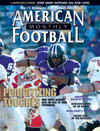AMERICAN FOOTBALL MONTHLY THE #1 RESOURCE FOR FOOTBALL COACHES
Article CategoriesAFM Magazine
|
The Drills Report - Advanced Wide Receiver Drillsby: Kevin BourgoinOffensive Coordinator, University of Maine © More from this issue I have been coaching college football for more than ten years, all of them as a receivers coach at various levels of competition and talent. One of the beliefs I’ve developed over that period of time is that many receivers do not know how to properly catch a football. They have not been taught nor do they use the proper fundamentals and techniques needed to accomplish this basic but critical task. Many coaches believe a player is either born with the natural ability to catch a football or not. I disagree. I believe one can develop and improve upon this skill. The process has been accomplished by using ball skills that improve hand-eye coordination. These ball skills have drastically reduced the number of dropped balls, increased the number of catches and boosted the yards per catch by receivers in our program. At the....The full article can only be seen by subscribers. Subscribe today!
|
|
|||||||
| HOME |
MAGAZINE |
SUBSCRIBE | ONLINE COLUMNISTS | COACHING VIDEOS |
Copyright 2025, AmericanFootballMonthly.com
All Rights Reserved





